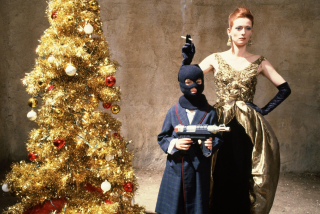Special Effects
- Share via
Hopping moon creatures explode in bursts of smoke upon being whacked with an umbrella; stars transform into heavenly maidens; a giant ice monster emerges from the North Pole to terrorize explorers; and a musician clones himself into a small band.
This might sound like the latest surreal fantasy from director Terry Gilliam or perhaps the product of George Lucas’ Industrial Light and Magic special-effects studio. Yet all are from films made nearly 100 years ago by French film pioneer Georges Melies, the man Charlie Chaplin once hailed as “the alchemist of light.”
“I was used to thinking that [early silent] films were rough in their style and ridiculous,” said Paolo Cherchi Usai, senior curator of film at the International Museum of Photography at the George Eastman House in Rochester, N.Y. His mind changed after seeing Melies’ 1902 film “A Trip to the Moon,” one of the most popular movies of its time.
It made Usai realize that even the earliest cinematic efforts could be “extremely sophisticated. . . . By 1902 standards, it was extraordinary, and I think that it still is.”
So intrigued was Usai with “A Trip to the Moon” and other films that he went on to write a biography of Melies.
He also assembled an internationally touring exhibition, “A Trip to the Movies: Georges Melies, Filmmaker and Magician (1861-1938),” which opens at the Muckenthaler Cultural Center in Fullerton on Saturday.
The show, which has been to Japan, Canada and Australia, features 67 small photographs, none bigger than a postcard. These shots, taken by Melies, are considered to be the first publicity movie stills.
Melies was a master illusionist and magician who is widely credited with developing trick photography as a new approach to filmmaking.
That discovery may have been a happy accident. A popular story has Melies filming a street scene and, just as a carriage was going by, his camera jammed. By the time he got the film running again, a hearse was passing by. Upon viewing the developed reel, he discovered that the carriage had miraculously turned into a hearse.
Movie magic was born.
He made all kinds of films, from melodramas and fairy tales to those documenting everyday life and staged reconstructions of special events such as the 1901 coronation of Edward VII.
Before he was a filmmaker, Melies was a magician, a profession that helped him come up with the whole repertory of cinematic trickery: appearances and disappearances, superimpositions and double exposures, fast motion and stop action.
Most of these tricks were carried out in camera without the aid of editing. He also sometimes hand-tinted films frame by frame to add color.
In fact, he handled all aspects of the creation of his films, from sketching storyboards and writing scripts to directing, producing, shooting and often starring in them.
His accomplishments in science fiction, influenced by the writings of Jules Verne and H.G. Wells, established him as the father of science fiction film.
“Now I realize that [his films are] where I got the ideas for my cartoons and films from; in fact, he even did an early version of Baron Munchausen,” said Terry Gilliam, the former Monty Python member who directed that comedy troupe’s films before moving on to direct “The Fisher King,” “The Adventures of Baron Munchausen” and “Brazil,” among others.
“His films were made with such flair and panache, and are wonderfully silly when everyone else was being very serious,” Gilliam told a British interviewer in 1993.
One example of Melies’ liberating silliness is a scene in “The Melomaniac.” In it, Melies’ own head is replicated, bouncing up to telegraph wires hung to look like the bars on the musical staff. The heads, assembled as notes, then proceed to sing “God Save the King.”
That was just one of the ways Melies helped transform the medium from one that, before him, was merely looked on as a tool of science. Popular films of the day by his competitors, the pioneering Louis and Auguste Lumiere brothers, consisted of views of everyday events such as workers leaving a factory.
After him, and those he influenced, film’s potential as an art form became clear.
Melies saw film as an extension of the theater, and took over where the Lumiere Brothers left off, renewing the medium’s waning appeal.
With his trick photography, while others were filming trains coming into stations, Melies was taking his trains to the stars.
Arthur Taussig, professor of film and photography at Orange Coast College, will give a talk at Saturday’s opening of the exhibit. Excerpts from various of his films will be shown, along with his seminal work, “A Trip to the Moon,” which will be screened in its entirety.
“It is so incredibly, phenomenally original, stunning, no precedent to it,” Taussig said. “Technically--the special effects, the dissolves, the stop frame, the masking, the idea of whacking the moon creature with an umbrella as a weapon--all wonderful.”
Melies made more than 500 films between 1896 and 1913 with his Star-Film Co.; most were only minutes long. A little more than 100 survive. Melies himself is responsible for destroying many of those not lost in World War I, when film stock was frequently confiscated and stripped of silver nitrate and other minerals it contained.
Having seen his career as a producer effectively ended by the war and by his inability to compete with larger film studios, he returned to the stage as a magician, performing until 1920 at his own Thea^tre Robert-Houdin.
Because of bad business decisions, he lost the theater five years later. Finally, in a fit of rage over the continued pirating of his films, he burned all remaining negatives and vanished.
He wasn’t seen again until four years later, when a journalist spotted him selling toys in a Paris train station. Once word got out about his plight, a retrospective of his work was mounted and he was fe^ted as the Father of French Cinema. He was made a Chevalier of the Legion of Honor in 1933 and died at 77, in 1938, in an old-actors’ home in Orly.
Usai said that viewers of the Melies exhibition should come away not only with a new appreciation for a film pioneer, but with a new outlook on the history of film and modern technology.
He hopes the show “helps put our own technological ambitions and advances in perspective. Maybe 100 years from now, we’ll be called the primitives and someone will have to stand up and fight and say that we certainly didn’t see ourselves as primitive. It’s a lesson in humility.”
* What: “A Trip to the Movies: Georges Melies, Filmmaker and Magician (1861-1938)”
* When: Opens Saturday and runs through Oct. 6, 10 a.m.-4 p.m. Tuesdays-Saturdays, noon-5 p.m. Saturdays and Sundays.
* Where: Muckenthaler Cultural Center, 1201 W. Malvern Ave., Fullerton.
* Whereabouts: Exit the Orange (57) Freeway at Chapman Avenue in Fullerton; go west. Bear right at Malvern Avenue and turn right at Buena Vista Drive to reach the center’s parking lot.
* Wherewithal: $1 to $2.
* Where to call: (714) 738-6595.
More to Read
The biggest entertainment stories
Get our big stories about Hollywood, film, television, music, arts, culture and more right in your inbox as soon as they publish.
You may occasionally receive promotional content from the Los Angeles Times.










